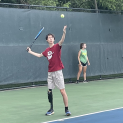Adaptation of acute lymphoblastic leukemia (ALL) to the post-transplant allogeneic environment.
Institution:
University of RochesterResearcher(s):
Craig MullenGrant Type:
Innovation GrantsYear Awarded:
2009Type of Childhood Cancer:
Acute Lymphoblastic Leukemia (ALL)Project Description:
The most common childhood cancer is acute lymphoblastic leukemia. While three-quarters of these children are cured, about one-quarter relapse. The prognosis for these children is poor without very aggressive treatment that includes bone marrow transplantation. Even with transplant the risk of relapse is still high. Doctors and scientists do not fully understand the reasons the leukemia comes back after transplant.
This research project studies why some leukemias relapse after transplant. To do this it will use a very sophisticated model of leukemia in mice. The leukemia used in these studies actually has the mutations that are present in human acute lymphoblastic leukemia. The bone marrow transplant model is very similar to the clinical situation in which a matched brother or sister serves as a donor in human bone marrow transplantation. The reason some scientists study mouse leukemias instead of human leukemias is that with a mouse system they can perform experiments that are not feasible in human patients. However, the mouse experiments very often give very important answers that then allow scientists to test them with leukemias from patients.
Using this model, it has been discovered that in acute lymphoblastic leukemias that relapse after bone marrow transplant, a small number of genes are turned on. One of these genes is "stem cell antigen-1", a gene that is known to be very important in normal blood stem cell function. This project will study whether this gene plays a role in allowing the leukemia to relapse after bone marrow transplant.

